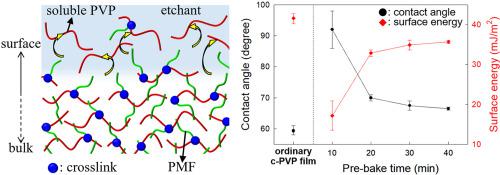Organic Electronics ( IF 3.2 ) Pub Date : 2021-09-16 , DOI: 10.1016/j.orgel.2021.106345 Jin-Hyuk Kwon 1 , Jonghee Lee 2 , Min-Hoi Kim 1, 2 , Jin-Hyuk Bae 3, 4 , Jaehoon Park 5

|
We propose a feasible method of manipulating the surface energy of crosslinked poly(4-vinylphenol) (c-PVP) thin films through the surface compositional modification assisted by an etchant. A physical picture of the surface-energy manipulation of c-PVP thin films based on the surface-selective molecular subtractive approach is clarified by investigating the chemical composition of the c-PVP film surfaces. We reveal that the molecular detachment by solvation on the surface leads to a reduction in the surface PVP density, thereby decreasing residual hydroxyl groups on the surface. In particular, it is found that the surface energy of a c-PVP thin film can be controlled by exploiting the thermal-treatment-time dependence of the soluble-PVP density. Organic thin-film transistors (TFTs) are fabricated via a solution process for demonstrating the applicability of our surface-energy-engineered c-PVP film as a gate insulator. The TFTs with the engineered c-PVP gate insulators exhibit improved electrical characteristics, compared to those with ordinary c-PVP gate insulators.
中文翻译:

用于溶液处理有机薄膜晶体管的交联聚(4-乙烯基苯酚)绝缘体的分子减法表面能工程
我们提出了一种通过蚀刻剂辅助的表面成分改性来操纵交联聚(4-乙烯基苯酚)(c-PVP)薄膜表面能的可行方法。通过研究 c-PVP 薄膜表面的化学成分,阐明了基于表面选择性分子减法方法的 c-PVP 薄膜表面能操纵的物理图片。我们揭示了表面溶剂化导致的分子分离导致表面 PVP 密度降低,从而减少了表面上的残留羟基。特别是,发现可以通过利用可溶 PVP 密度的热处理时间依赖性来控制 c-PVP 薄膜的表面能。有机薄膜晶体管 (TFT) 是通过溶液工艺制造的,以证明我们的表面能工程 c-PVP 薄膜作为栅极绝缘体的适用性。与具有普通 c-PVP 栅极绝缘体的 TFT 相比,具有工程化 c-PVP 栅极绝缘体的 TFT 表现出改进的电气特性。


























 京公网安备 11010802027423号
京公网安备 11010802027423号